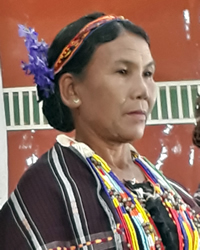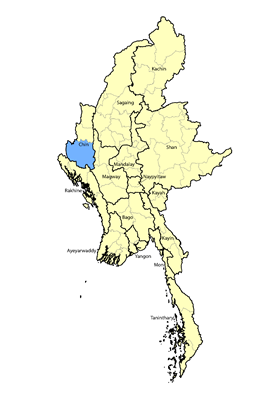Although the Matu are recognized as a subgroup of the larger Chin people in Myanmar, they are a collection of smaller tribes and subgroups that have developed separately due to the extreme terrain that has made it difficult for groups to interact. This fragmentation has led to several names being used. For example, in Matupi many Matu people call themselves “Ngala,” while people in Mindat refer to all the Matu as “Batu.”
Location: Numbering 34,000 people, the Matu are the largest ethnic group in Matupi Township, which sits in southern Chin State in western Myanmar. The total population of Matupi was 50,580 in 2009, which means the majority of people in the township are Matu. The region consists of a series of high mountains and deep valleys, with the highest peak, Awtaraw, standing over 9,000 feet (2,746 meters) above sea level. More than 10,000 Matu people also live across the border in the Indian state of Mizoram, where they are classified as part of the Mizo tribe. Matu families are also known to have migrated to several Western countries, including the United States and Australia.
Language: The Matu language in Myanmar consists of ten known dialects, although there is mutual intelligibility to some extent among all of them. Matu is also related to the Rawngtu and Thaiphum languages.1 Most Matu people today can also speak Burmese and Lai Chin as second languages. The variety of Matu spoken in India is reportedly not intelligible with any of the Matu dialects spoken in Myanmar.
For most of their history, the Matu people have been isolated from the rest of Myanmar and the world by the rugged mountains and thick forests that encircle them. Most of the rivers and streams in the region are fed by water flowing down from the hills, with the many whitewater rapids making navigation unsuitable for boats. For centuries, the only way to reach the Matu territory was on foot, which was a difficult and dangerous undertaking.
Although Matu women today wear beautiful and elaborate dresses adorned by numerous necklaces and waist rings, missionary Chester Strait, who arrived in the area in 1925, observed: “The Matu, due apparently to their lack of cotton, wear diminutive loincloths.”2 The forests of Matupi are teeming with wildlife, including pangolin, tigers, leopards, bears, porcupines, and many species of monkeys. Although about 90 percent of Matu people grow their own crops for food, the area still depends on importing rice from the lowlands due to the lack of suitable land for rice cultivation. The timber industry provides tough work for many Matu men. Teak and other hardwoods are located below 3,000 feet (900 meters), while oak and pine trees grow at higher elevations.
The influence of Animism in Matu society is reflected in the 1931 census, when all Maru persons declared they were animists and not a single person identified as a Christian. Revival came to the Matupi area after the bold witness of missionaries from other Chin tribes, and today approximately 80 percent of Matu people are professing Christians. The publication of the full Bible into Matu in 2006 provided a breakthrough in the spiritual lives of many people.
Many Matu Christians are full of life and grace, and over the years believers have obeyed the Great Commission by traveling far from their homeland to spread the Gospel, not only in other parts of Myanmar but in Southeast Asia, the Pacific Islands, and other parts of the world. One source says of Matupi: “Baptists are the predominant group, constituting more than 60 percent of the township's population. It is the fastest growing Christian area in Chin State…. The town of Matupi is home to a theological college.”
Scripture Prayers for the Matu in Myanmar (Burma).
| Profile Source: Asia Harvest |











